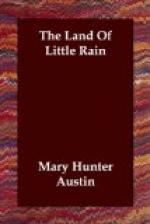Since no lake can be at the highest point, it is possible to find plant life higher than the water borders; grasses perhaps the highest, gilias, royal blue trusses of polymonium, rosy plats of Sierra primroses. What one has to get used to in flowers at high altitudes is the bleaching of the sun. Hardly do they hold their virgin color for a day, and this early fading before their function is performed gives them a pitiful appearance not according with their hardihood. The color scheme runs along the high ridges from blue to rosy purple, carmine and coral red; along the water borders it is chiefly white and yellow where the mimulus makes a vivid note, running into red when the two schemes meet and mix about the borders of the meadows, at the upper limit of the columbine.
Here is the fashion in which a mountain stream gets down from the perennial pastures of the snow to its proper level and identity as an irrigating ditch. It slips stilly by the glacier scoured rim of an ice bordered pool, drops over sheer, broken ledges to another pool, gathers itself, plunges headlong on a rocky ripple slope, finds a lake again, reinforced, roars downward to a pot-hole, foams and bridles, glides a tranquil reach in some still meadow, tumbles into a sharp groove between hill flanks, curdles under the stream tangles, and so arrives at the open country and steadier going. Meadows, little strips of alpine freshness, begin before the timber-line is reached. Here one treads on a carpet of dwarf willows, downy catkins of creditable size and the greatest economy of foliage and stems. No other plant of high altitudes knows its business so well.
It hugs the ground, grows roots from stem joints where no roots should be, grows a slender leaf or two and twice as many erect full catkins that rarely, even in that short growing season, fail of fruit. Dipping over banks in the inlets of the creeks, the fortunate find the rosy apples of the miniature manzanita, barely, but always quite sufficiently, borne above the spongy sod. It does not do to be anything but humble in the alpine regions, but not fearful. I have pawed about for hours in the chill sward of meadows where one might properly expect to get one’s death, and got no harm from it, except it might be Oliver Twist’s complaint. One comes soon after this to shrubby willows, and where willows are trout may be confidently looked for in most Sierra streams. There is no accounting for their distribution; though provident anglers have assisted nature of late, one still comes upon roaring brown waters where trout might very well be, but are not.




